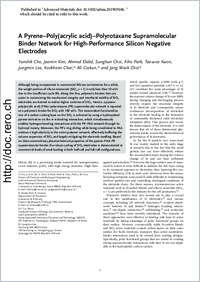A pyrene–poly(acrylic acid)–polyrotaxane supramolecular binder network for high-performance silicon negative electrodes
- Cho, Yunshik School of Chemical and Biological Engineering and Institute of Chemical ProcessesSeoul National University 1 Gwanak‐ro, Gwanak‐gu Seoul 08826 Republic of Korea
- Kim, Jaemin School of Chemical and Biological Engineering and Institute of Chemical ProcessesSeoul National University 1 Gwanak‐ro, Gwanak‐gu Seoul 08826 Republic of Korea
- Elabd, Ahmed Department of ChemistryUniversity of Fribourg Chemin de Musee 9 Fribourg 1700 Switzerland
- Choi, Sunghun School of Chemical and Biological Engineering and Institute of Chemical ProcessesSeoul National University 1 Gwanak‐ro, Gwanak‐gu Seoul 08826 Republic of Korea
- Park, Kiho School of Chemical and Biological Engineering and Institute of Chemical ProcessesSeoul National University 1 Gwanak‐ro, Gwanak‐gu Seoul 08826 Republic of Korea
- Kwon, Tae‐woo Graduate School of Energy, Environment, Waterm, and Sustainability (EEWS)Korea Advanced Institute of Science and Technology (KAIST) 291 Daehak‐ro, Yuseong‐gu Daejeon 34141 Republic of Korea
- Lee, Jungmin Samsung SDI R&D Center 130 Samsung‐ro, Yeongtong‐gu Suwon Gyeonggi‐do 16678 Republic of Korea
- Char, Kookheon School of Chemical and Biological Engineering and Institute of Chemical ProcessesSeoul National University 1 Gwanak‐ro, Gwanak‐gu Seoul 08826 Republic of Korea
- Coskun, Ali Department of Chemistry, University of Fribourg, Switzerland
- Choi, Jang Wook School of Chemical and Biological Engineering and Institute of Chemical ProcessesSeoul National University 1 Gwanak‐ro, Gwanak‐gu Seoul 08826 Republic of Korea
-
2019
Published in:
- Advanced Materials. - 2019, p. 1905048
English
Although being incorporated in commercial lithium‐ion batteries for a while, the weight portion of silicon monoxide (SiOx, x ≈ 1) is only less than 10 wt% due to the insufficient cycle life. Along this line, polymeric binders that can assist in maintaining the mechanical integrity and interfacial stability of SiOx electrodes are desired to realize higher contents of SiOx. Herein, a pyrene–poly(acrylic acid) (PAA)– polyrotaxane (PR) supramolecular network is reported as a polymeric binder for SiOx with 100 wt%. The noncovalent functionalization of a carbon coating layer on the SiOx is achieved by using a hydroxylated pyrene derivative via the π–π stacking interaction, which simultaneously enables hydrogen bonding interactions with the PR– PAA network through its hydroxyl moiety. Moreover, the PR's ring sliding while being crosslinked to PAA endows a high elasticity to the entire polymer network, effectively buffering the volume expansion of SiOx and largely mitigating the electrode swelling. Based on these extraordinary physicochemical properties of the pyrene–PAA–PR supramolecular binder, the robust cycling of SiOx electrodes is demonstrated at commercial levels of areal loading in both half‐cell and full‐cell configurations.
- Faculty
- Faculté des sciences et de médecine
- Department
- Département de Chimie
- Language
-
- English
- Classification
- Chemistry
- License
-
License undefined
- Identifiers
-
- RERO DOC 327693
- DOI 10.1002/adma.201905048
- Persistent URL
- https://folia.unifr.ch/unifr/documents/308334
Other files
Statistics
Document views: 82
File downloads:
- pdf: 483
- Supplementary material: 202

